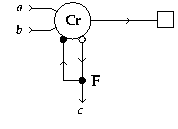DI Decompositions
-
A Merge can be implemented with
a Resettable Join
using a Fork and
an I-Wire:

[Zoom|FIG]
Using Boolean Gates
- The Merge can be implemented as an XOR gate.
Using Transistors
No information available


Specification in XDI model:
(AND/IF_1.0
(NFA
(NAME Merge)
(SYMBOLS
(a INPUT) (b INPUT) (c OUTPUT)
)
(STATES
(0 INITIAL BOX)
(1 TRANSIENT)
)
(TRANSITIONS
(0 1 a) (0 1 b)
(1 0 c)
)
)
)
Also available through this link
Specification in Verdect:
define MERGE( a?, b?, c! ) =
pref *[ (a? | b?); c! ]
end
Also available through this link
Specification in DI Algebra:
NAME = "Merge"
I = { a?, b? }
O = { c! }
M = [ a? -> c!; M ,
b? -> c!; M
]
Also available through this link
The roles of inputs a and b can be interchanged:
M(a, b; c) =
M(b, a; c)
The Merge specification requires a choice between inputs from the environment in state 0.

No information available
In [Ornstein67, p. 347] and [Dickson74, p. 44], the Merge is referred to as Merge Element.
In Section 2.2.5 of [Ebergen89, pp. 31-32], the Merge is referred to as XOR component.